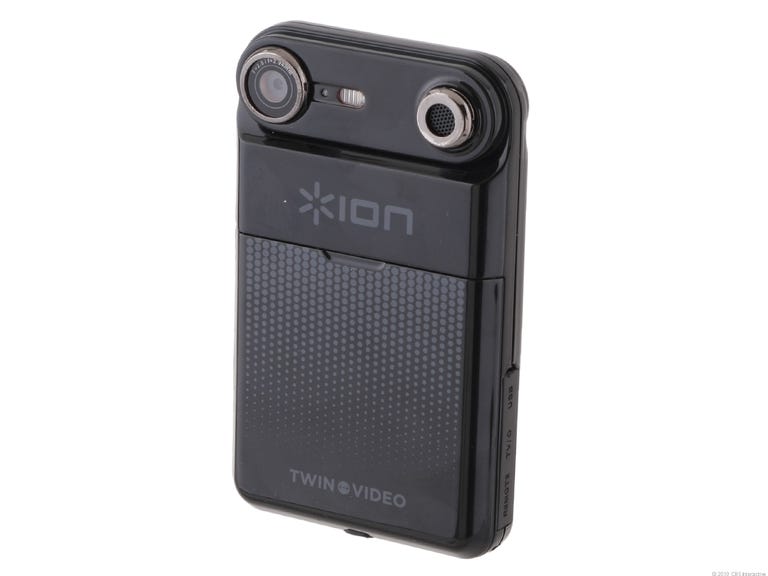The Ion Twin Video pocket video camera is a bit of an oddball in the category. It's missing what these devices are known for these days: HD video, a built-in USB connector for offloading video and photos and charging without a cable, and embedded sharing software. However, it has something that no other minicamcorder has: front- and rear-facing lenses.
The Good
The Bad
The Bottom Line
The dual-lens (and dual-mic, too, for that matter) design lets you easily record yourself and, at the press of a button, switch to recording what's in front of you. That means if you want to be in your movie, you don't have to do any awkward flipping of the camera or any editing.
To accommodate the two lenses, the Twin Video's body is wider than a typical minicamcorder, which could make it tough to grip for smaller hands. Luckily, Ion Audio includes a weighted handle that screws into a standard tripod mount in the bottom of the device. The handle not only allows you to hold the Twin Video comfortably out in front of you, but because of its weight it can do double duty as a stand. Next to each lens is a small LED for lighting and a microphone.
The device casing is made of glossy plastic (it becomes covered in fingerprints as soon as you pick it up) and is so lightweight it feels cheap and fragile, but it's actually fairly sturdy. Plus, since it is so light, you can throw it in a bag or pocket and not be weighed down. Below the lenses on top you have a 2.4-inch LCD, a You/Me button for switching video streams, and some simple controls.
Aside from the record button that's front and center, there's a Mode button for jumping from recording movies to shooting photos and then into playback so you can view what you've recorded. A Set/Delete button opens up a list of four settings: Lighting (turns the LEDs on and off), Format (for formatting an SD card), TV system (NTSC or PAL), and Light frequency (50Hz or 60Hz); it will also delete movies and photos from your SD card when in playback. The two remaining buttons control the 3x digital zoom and handle menu/content navigation and volume. That's it for controls and shooting options, though, so if you're after a basic point-and-shoot minicamcorder, this is as simple as it gets.

On the right side are a power button, a mic gain switch (low/high), and a covered SD/SDHC card slot. The Twin Video comes with a 2GB SD card. On the left side is another port cover concealing a Mini-USB port and a jack for a wired remote trigger for switching video streams (also included). Unfortunately, there's no external mic jack, which is a shame considering how nice the Twin Video is for interviews. You're limited to the internal mics and you need to be fairly close to them to record normal conversation. The remote trigger is a nice touch, though: it eliminates camera movement from switching lenses when shooting handheld, and makes it easier to shoot on a tripod.
The Twin Video is powered by a rechargeable lithium ion battery housed behind a slide-down door in front. Ion claims up to a 4-hour battery life; I got about 3 hours from it in testing, but that was with me using the LEDs and constantly turning the device on and off. The minicamcorder is charged via USB when connected to a computer or a USB wall adapter. As mentioned above, there is no built-in USB arm so you have to use a cable or a card reader to get to your videos and photos, and there's no embedded editing and sharing software on the device; a disc with ArcSoft's MediaImpression software (Windows only) is included.
Video quality is OK. It records in VGA only (640x480-pixel resolution) at 30 frames per second and is so loaded with artifacts that you'll only want to use the video for posting on YouTube or other video-sharing sites. It records in MPEG-4 (MP4), too, so if you need to transcode the video for some reason, the results are only going to get worse. Also, when you switch between lenses the video will freeze for a split second; not a big deal, but it's not the smooth switch I was expecting.
Conclusions
The Ion Twin Video is a very basic pocket video camera with one handy feature. The lens switching is cool, the device is simple to use, and it works. If you can't think of any good ways to use the dual lenses, though, then I wouldn't recommend buying it. I also wouldn't get it if you need video quality good for something other than video-sharing sites. Or if you want any control over results at all, because this thing won't even let you set the date and time. On the other hand, it is cheap. It's available directly from Ion for $119.99, but can be found at retail for less than half that price. Considering all that's included, the Twin Video is a decent minicamcorder option for Web video, if nothing else.
Find out more about how we test camcorders.



